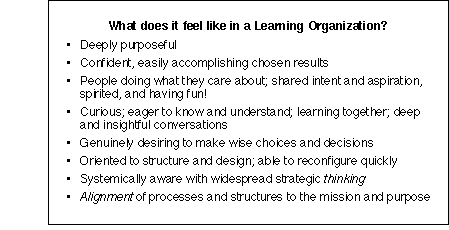
Groupware applications have been slow to take-off, despite their obvious benefits of collaboration and sharing. Why should we be surprised? Without computer mediation, it has been hard to get real sharing and collaboration in our organizations, and including technology in the equation may be making things worse, not better. The limiting factor is not technology, but our theories, tools, and methods for achieving major culture change in organizations. In the past few years, the Learning Organization concepts have shed new light on this field. The purpose of this paper is a brief tour of the Learning Organization and what we've learned about the relationship to Groupware.
Groupware is synergistic with the Learning Organization concepts. The principles and disciplines of the Learning Organization can substantially help achieve the change involved in today's technology projects. If Groupware can truly support communication, collaboration, and coordination, then it will play an important enabling role for the Learning Organization.
In this paper, I will follow the definitions and disciplines of the Learning Organization as outlined by Senge and by Nonaka and Takeuchi.
Most of my career has been as a manager in high-tech entrepreneurial organizations, and I am now a practicing organizational consultant. Although I have some technical background, I'm a Groupware user, not a Groupware expert. I don't expect you to accept without challenge anything I say here. But, I do hope that by sharing my experiences and beliefs, and by being a provocateur, this may launch something for some among you who read this.
Following Senge, I will use these definitions:
Knowledge: Capacity for effective action.
Learning: Increasing knowledge, that is, increasing capacity for effective action.
Learning Organization: When the organization as a whole and the people who comprise it are continually increasing their capacity to produce the results they really want to produce.
In simple terms, we use learning in the sense of learning to do, not in the sense of knowing things.
A learning organization harnesses the collective intelligence and commitment at all levels of the organization. Although this may seem like motherhood, we still refer to the senior person in a group as the "head," and it was not so long ago that the majority of the people in an organization might be called "hands." Organizations in general have a long way to go before they can truly be called Learning Organizations.

Fig. 1 -- What does it feel like in a Learning Organization?
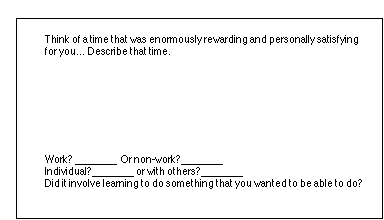
Fig. 2 -- Most people report that learning to do is enormously rewarding and personally satisfying.
For the organization: It's simple! Today's performance requirements make it essential. We find that in industry after industry, the performance challenges today from competition, globalization, technology changes, shorter cycle times, customer demands, etc. are remarkably intense. Not just in commercial enterprises, but in government, health care, and non-profits, the pressures are just as high. Many leaders are concluding that successful business strategies require them to become more of a learning organization.
For the people involved, learning is fundamental in human nature. When we ask people about the times which have been the most rewarding and personally satisfying (see Fig. 2 above), there is a consistent response. The most rewarding and personally satisfying experiences involve a significant element of learning to do. And, it's not just learning to do anything; but learning to do something we care about. Kids learn to talk, walk, and ride a bike because they want to. Not for rewards, not for approval, but because they want to.
The Win-Win prospect of the Learning Organization excites us. The organization achieves higher performance and the people find personal reward and satisfaction. The prospect is to get out of the either-or tradeoff that increased performance for the organization can come only at the expense of the people.
First, Senge has identified five disciplines essential to building a learning organization. These are disciplines in the sense that they deserve study and attention for a very long period of time, perhaps throughout a lifetime, not skills to be mastered quickly.
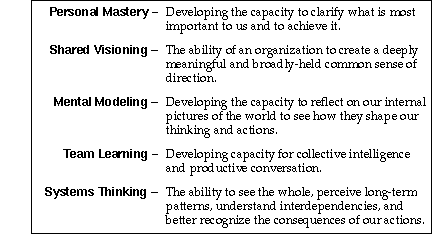
Fig. 3 -- Senge's Five Learning Disciplines -- Disciplines are areas of personal improvement that might be worthy of study and practice over an extended period of time.
Senge's approach to Mental Models draws heavily from the work of Chris Argyris.[2]
Second, from a different cultural background, Nonaka and Takeuchi complement Senge by focusing on the distinction between Tacit Knowledge and Explicit Knowledge. "Tacit knowledge is personal, context-specific, and therefore hard to formalize and communicate. Explicit... Knowledge, on the other hand, refers to knowledge that is transmittable in formal, systematic language."[3] In my personal experience, I see the distinction clearly: I have Tacit Knowledge when I know how to do something, but would have trouble describing how to another person. I have Explicit Knowledge when I tell or write down the important how-to information. Clearly, viewing knowledge as the ability to do, then our organizations are rich in Tacit Knowledge. We would like them to be richer in Explicit Knowledge.
Simplistically, knowledge is created as Tacit Knowledge by individuals, then made explicit and shared. But this simplistic a view would be confuse information with knowledge. The acquisition of knowledge (ability to do) involves much more than taking-in information. Knowledge, for Nonaka and Takeuchi, involves action and is not just intellectual, but resides in part in the body. From my Western point of view, I can understand this as knowledge is tentative until practiced.
This is a real change from our usual Western way of thinking, but the difference is confusing, subtle, and difficult to see clearly. In Western culture, we see ourselves as people of action. Knowledge enables action in both cultures, but, there is a difference in our models for where knowledge comes from. We carry consciously or unconsciously DeCartes' insight, "I think, therefore I am!" Our Western model is that thinking gives us the knowledge that enables us to act. We properly see the Eastern tradition as more reflective, more contemplative. But, the Eastern epistemological tradition emphasizes knowledge coming from careful observation of and reflection upon experience. Does knowledge come from thinking? Or from experience? Both seem important.
Nonaka and Takeuchi go on to describe four modes of knowledge conversion which they propose are the processes for knowledge creation: "In our view, however, tacit and explicit knowledge are not totally separate but mutually complementary entities. They interact with and interchange into each other in the creative activities of human beings. Our dynamic model of knowledge creation is anchored to a critical assumption that human knowledge is created and expanded through social interaction between tacit knowledge and explicit knowledge... This... conversion is a `social' process between individuals and not confined within an individual."[4]
Nonaka and Takeuchi see a spiraling process through these four quadrants[5]
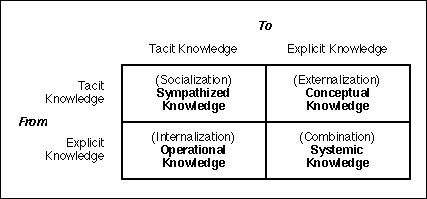
Fig. 4 -- Knowledge is created by human interaction when knowledge is transformed within a type or between types. The process is a spiral through the four quadrants.
Third, and finally, the Learning Organization recognizes that there are differences in personal communication styles and that these can be quite significant. We tend to think that people can adjust to our technology, that the benefits will win over, but my own experience has been largely contrary. Here is a short personal story: I took a job as the VP-Marketing for a very high technology software company (artificial intelligence, object-oriented programming, etc.). One of the senior technical people, to my great disappointment, was completely ineffective in face-to-face meetings. And, we needed his contributions on the team! Then, I began to realize that in e-mail he was articulate, insightful, helpful, everything you could want! We've all met the opposite: effective people who are just not able to cope with computers and e-mail.
I believe these differences in personal communication style are very significant, that it can be very difficult for people to shift styles, and that this is an element of diversity to be nurtured, not shut-down.[6]
This has been an exceedingly brief tour through the models underlying the Learning Organization. I suggest that the reader mull these over, try them on for size, and read further in the references if interested.
In our own company, Innovation Associates, we felt a need in 1993 for better computer support for collaborative discussion, especially for some current "hot" issues. We had computers in use throughout the company for document preparation and very active e-mail usage by LAN and remote dial-in users. Topic-based computer conferencing seemed like just the ticket.
A reasonable amount of thought was put into structuring the conference into topics, creating the technical mechanisms, obtaining resources, and getting people started. We kept the existing e-mail to hold down the investment, but this made the conferencing system "additive." Participation, at least initially, was "required." The enthusiasts among us tried valiantly to create enough "good stuff" to create "critical mass," but this never occurred. Participation dwindled to a core few. After some technical problems and an episode of lost information, the whole thing disappeared.
The next "obvious" application was shared schedule/calendar, but after this failure, we didn't dare.
Discussion:
I'm sure this case is not unique. Assume for a moment that the technology employed was capable of supporting the desired outcomes. Why, despite the obvious benefits, in a company where most people really are committed to mutual learning and sharing, did it fail to take-off? If the sharing benefits of Groupware won't sell here, it'll be harder in more traditional organizations. What could the Learning Organization ideas contribute to this and to other Groupware projects?
I believe, for starters, we suffered from the thought that Groupware was good enough that the benefits would sell themselves, creating momentum. The project was launched by a few of us who were especially pro-technology. In hindsight, I believe that the generic benefits of Groupware are just not strong enough to create the momentum for change that's required.
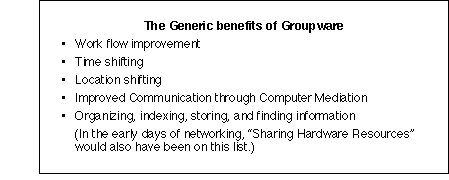
Fig. 5 -- The generic benefits of Groupware are significant, but not enough to overcome resistance to organization and culture change.
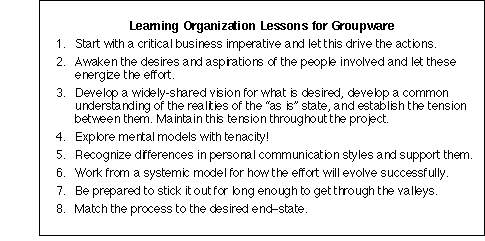
Fig. 6 -- Lessons from Innovation Associates' work in building Learning Organizations which may apply to Groupware and other technology implementation projects.
Sometimes this is a "hot" current issue, but more often the current issues are transitory and the really important business imperatives that could drive and sustain a major change are deeper, overarching, and more consistent over time. They may be less obvious in the moment and must be "discovered" in order to create and channel the energy of the organization.
In our case, the need to make progress on the current issues was transitory. The deeper critical need to support mutual learning throughout the staff, to be able to develop new practitioners more easily -- this could have energized and sustained our project.
The quality of energy that flows when people are working on something that they really care about is different from the quality of energy when people are doing something because they should, or because they are told to do so, even if they know it's "good" or "right." This is the quality of energy to harness for our most important projects.
Energy, creativity, and innovation flow from the tension between "desired" and "as is."
Much of our early work was focused on creating the shared vision. We felt that this was the side most lacking in attention, that if we just had a clear and compelling vision of the future, then everything else would follow.
Our experience has been that it's equally demanding to be insightful about current reality, to create an honest, penetrating picture of the "as is" state, and that this has just as much impact on stimulating progress.
The tension will be difficult to hold. Organizations tend to see the gaps as threats. Someone must be to blame if things aren't the way they should be! Fear of a "who-hunt" leads people to disguise, hide, avoid, and lie; this may be conscious, and may also occur unconsciously. Leaders must support an environment in which the tension can be brought out into the open, as insight rather than blame, so that it can stimulate progress.
Leaders at all levels must maintain the tension throughout the project.
Our mental models of how things work in the world, in this organization, and between people generally -- these strongly affect our thinking and our actions. They are usually effective, and essential for our survival as a species. When a Saber-toothed Tiger came bounding out of the trees, we didn't need to do a lot of analysis!
The danger lies in mental models that are out-dated, inappropriate, ineffective, or just plain wrong. We believe that 30% of what an organization "knows" is not just wrong, it's toxic! And, this is most dangerous when the mental models are un-conscious or semi-conscious.
A simple example: In industries undergoing major change, people tend to carry in their heads, and act in accordance with, outdated models, obsolete paradigms, without realizing it. Bringing these out into the open, evaluating them, and reshaping for the new reality is hard work, but this is some of the highest leverage work we do in supporting organizational change.[7]
I believe that there is a rich opportunity for Groupware to mediate between different personal styles, enabling people to communicate well who would otherwise do so with great difficulty. Supporting increased diversity in human interaction could enrich us all.
Most often, we should be looking to create a reinforcing spiral in which success brings the interest, resources, and energy that create further successes. We need to beware of the slowing forces and resource limitations which could turn the upward spiral into a vicious cycle. We must attack these before they affect results. All this is simple to say, but not easy to do in practice. It's worth the attention.
In many important projects, progress will not be a nice, steady upward progression, but will include a significant valley during which leadership will be important to stay the course.
I give special emphasis, because of it's importance and frequency of failure, to matching the process to the desired end state. For example, if the desired end-state is collaboration and sharing, with respect for the intelligence and capacity at all levels, then the process for getting there should emphasize the same points. This is a particular opportunity for Groupware because the tools themselves can be used within the project teams in the course of the effort. Remember that it's not just the tools, but the way people interact with each other using the tools.
I believe that this case illustrates a project that "should" have succeeded and could have, if we had applied our own Learning Organization knowledge more fully.
Although sharing best practice is an important benefit, there is much more to organizational learning -- and much more that could be supported by Groupware. The Learning Organization is about marshaling energy and human spirit to create new works and new capacities. It is about creating new knowledge, not just about spreading information.
I see Groupware supporting Organizational Learning at three levels[9] (see Fig. 7 on the following page). Across all three levels, time- and location-shifting are important benefits.
Much more effective for the Organizational Learning applications at all three levels is a browsing paradigm[10] which supports: 1) seeking items when you are interested, not when they arrive in your mailbox; 2) a history of the discussion that's easy to access (e.g. an archive) so that people can join late or re-ignite it even later; and 3) search, classification, and indexing so that people experience a high hit rate when looking for something, even if their target is only partially defined. These are the advantages of conferencing systems over e-mail and I believe that conferencing systems are a closer fit than e-mail for most of the needs of Organizational Learning.
The challenge for Groupware is to create facilities that are more effective than face to face, in-meeting communication. I believe this is possible.
A current internet project of mine shows the one outstanding advantage of e-mail: broader reach. When I decided to launch a world-wide internet discussion of the Learning Organization, I chose an e-mail automated mailing list as the place to start, because it reaches so many more people than any other mechanism.
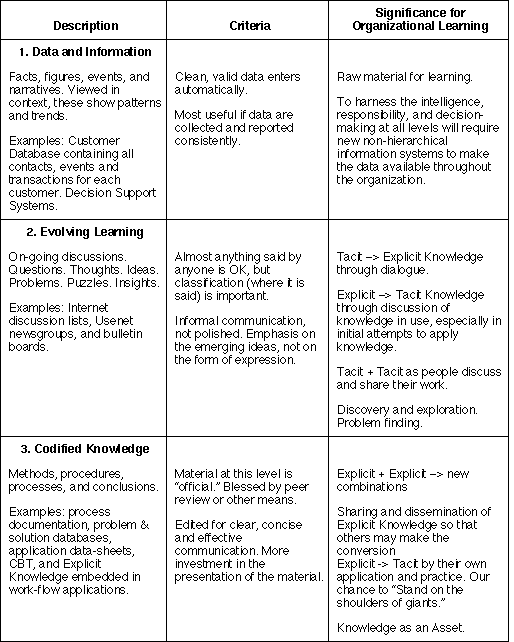
Fig. 7 -- Three levels of Groupware supporting Organizational Learning. At all three levels, time- and location-shifting are important benefits. The Browsing paradigm seems especially valuable.
Inter-operability relates to the earlier comments about personal communication styles. When we try to shoe-horn everyone into one form for in-house projects, I think this is working against important personal traits. I recommend that we take inter-operability seriously. This means supporting all the operating environments in which people want to work, and also the ways and styles in which they work most effectively. It means making provision (e.g. facilitating use by surrogates) for those who just don't get along with computers.
I'm reminded of a common story in continuous improvement efforts. In the course of a project we find that workers on the line were aware of an improvement opportunity for years, but didn't raise it. Why? "Aw, we knew it wouldn't go anywhere!"
I feel that point of focus should be on creating infrastructure that makes explicit knowledge more usable and valuable. By creating the infrastructure that makes it easier to transform tacit into explicit, that makes explicit knowledge available to others more effectively and more easily, that supports the application of explicit knowledge by another person thereby transforming it into new and enriched tacit knowledge -- then there will be an outpouring of explicit knowledge and more willingness to use it.
Groupware is a technology, the Learning Organization is an approach to organizational change and continuous improvement; the two are synergistic and mutually supportive.
Argyris, Chris. 1991. "Teaching Smart People How To Learn," Harvard Business Review, May-June 1991.
Karash, Richard. 1995. "Mental Models & Systems Thinking: Going Deeper into Systemic Issues," The Systems Thinker, Feb. 1995. (Published by Pegasus Communications, Inc., Cambridge, MA, 617-576-1231.)
Nonaka, Ikujiro. 1991. "The Knowledge Creating Company" Harvard Business Review, Nov.-Dec. 1991.
Nonaka, Ikujiro, and Hirotaka Takeuchi. 1995. The Knowledge-Creating Company. New York: Oxford University Press.
Senge, Peter M. 1990. The Fifth Discipline: The Art and Practice of the Learning Organization. New York: Doubleday.
Senge, Peter M., Charlotte Roberts, Richard B. Ross, Bryan J. Smith, and Art Kleiner. 1994. The Fifth Discipline Fieldbook. New York: Doubleday.
Seagal, Sandra, and David Horne. 1986-92. An Introduction to Human Dynamics. La Topanga, CA: Human Dynamics International.